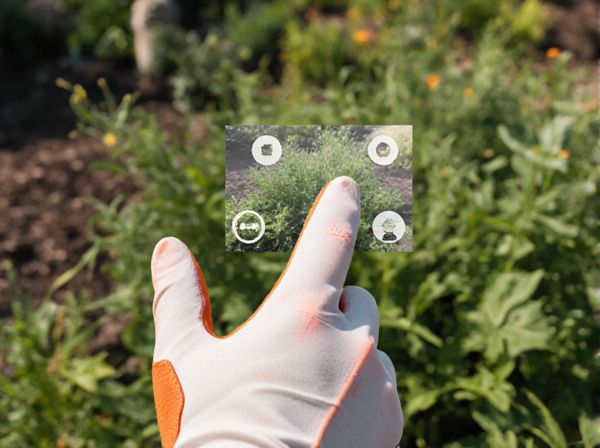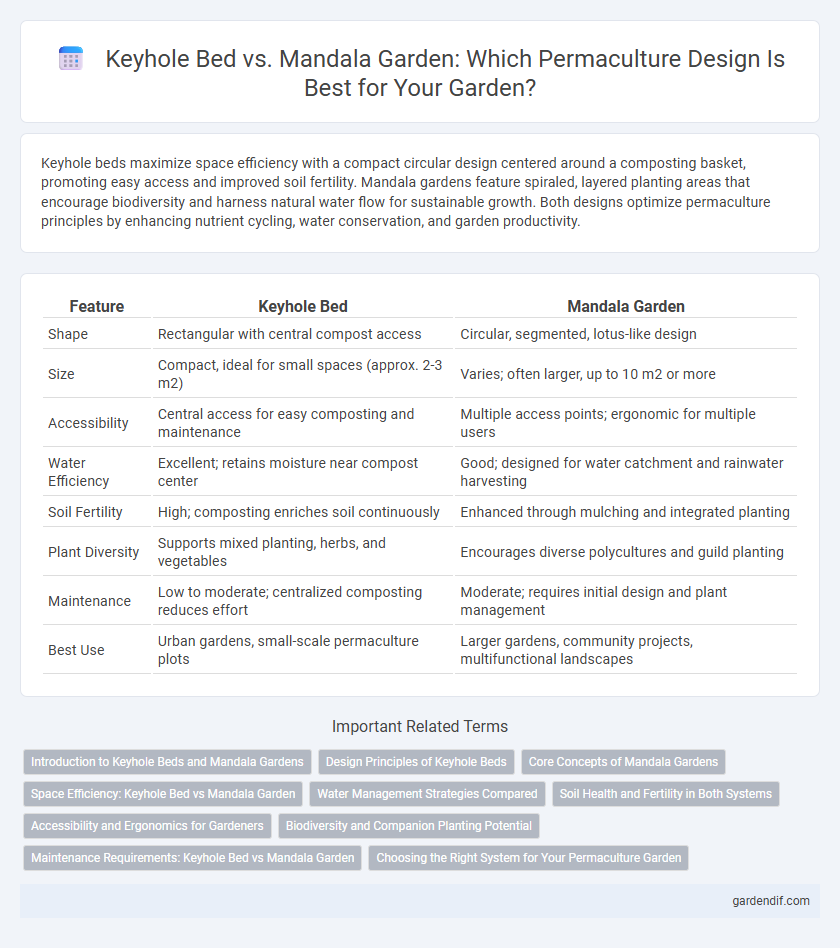
Keyhole Bed vs Mandala Garden Illustration
Keyhole beds maximize space efficiency with a compact circular design centered around a composting basket, promoting easy access and improved soil fertility. Mandala gardens feature spiraled, layered planting areas that encourage biodiversity and harness natural water flow for sustainable growth. Both designs optimize permaculture principles by enhancing nutrient cycling, water conservation, and garden productivity.
Table of Comparison
| Feature | Keyhole Bed | Mandala Garden |
|---|---|---|
| Shape | Rectangular with central compost access | Circular, segmented, lotus-like design |
| Size | Compact, ideal for small spaces (approx. 2-3 m2) | Varies; often larger, up to 10 m2 or more |
| Accessibility | Central access for easy composting and maintenance | Multiple access points; ergonomic for multiple users |
| Water Efficiency | Excellent; retains moisture near compost center | Good; designed for water catchment and rainwater harvesting |
| Soil Fertility | High; composting enriches soil continuously | Enhanced through mulching and integrated planting |
| Plant Diversity | Supports mixed planting, herbs, and vegetables | Encourages diverse polycultures and guild planting |
| Maintenance | Low to moderate; centralized composting reduces effort | Moderate; requires initial design and plant management |
| Best Use | Urban gardens, small-scale permaculture plots | Larger gardens, community projects, multifunctional landscapes |
Introduction to Keyhole Beds and Mandala Gardens
Keyhole beds maximize growing space through a circular design with a central composting basket, promoting nutrient recycling and easy access to plants. Mandala gardens feature concentric circles that create distinct planting zones for diverse crops, enhancing biodiversity and efficient water use. Both designs optimize permaculture principles by improving soil health and minimizing labor through strategic layout.
Design Principles of Keyhole Beds
Keyhole beds are designed with a central composting basket that maximizes nutrient recycling and efficient water use, promoting sustainable soil health. Their circular layout with inward-reaching paths enables easy access to all plants, optimizing space and reducing soil compaction compared to the radial symmetry of mandala gardens. This design principle supports intensive planting and ergonomic maintenance, making keyhole beds ideal for permaculture systems focused on productivity and resource conservation.
Core Concepts of Mandala Gardens
Mandala gardens emphasize circular design principles that maximize space efficiency and promote biodiversity through concentric planting zones. These gardens integrate ergonomic pathways and central features like water catchments to optimize resource use and accessibility. Core concepts include radiating plant beds that support companion planting, soil fertility, and microclimate variations to enhance permaculture productivity.
Space Efficiency: Keyhole Bed vs Mandala Garden
Keyhole beds maximize space efficiency with a compact design featuring a central composting basket, allowing easy access to plants within a small footprint ideal for limited garden areas. Mandala gardens, characterized by circular patterns and radiating beds, optimize space by enabling diverse plant arrangements and pathways that reduce soil compaction, suitable for larger or more decorative spaces. Both systems promote sustainable permaculture principles, but keyhole beds excel in tight spaces while mandala gardens offer flexibility and aesthetic appeal in moderate to ample areas.
Water Management Strategies Compared
Keyhole beds feature a central composting basket that enhances water retention and nutrient recycling, promoting efficient moisture use in permaculture design. Mandala gardens utilize concentric circular patterns with raised beds to maximize water capture and reduce runoff through strategic contouring and mulching techniques. Both designs prioritize sustainable water management, but keyhole beds excel in intensively managing water inputs in compact spaces, while mandalas offer broader surface water absorption and distribution.
Soil Health and Fertility in Both Systems
Keyhole beds and mandala gardens both enhance soil health through efficient nutrient cycling and moisture retention, but keyhole beds concentrate organic matter and compost in a central basket, promoting faster decomposition and targeted fertility. Mandala gardens utilize curved beds and perennial plants to create diverse root structures and microbial habitats, improving long-term soil structure and increasing biodiversity. Both systems minimize soil disturbance, reduce erosion, and support robust microbial communities, leading to sustained fertility and improved crop yields.
Accessibility and Ergonomics for Gardeners
Keyhole beds offer enhanced accessibility with a central path allowing gardeners to reach all parts of the bed without stepping on soil, which preserves soil structure and reduces compaction. Mandala gardens feature circular patterns with multiple access points, providing ergonomic benefits by minimizing bending and stretching through strategic plant placement and tiered levels. Both designs prioritize gardener comfort, but keyhole beds optimize reach within a compact footprint while mandala gardens emphasize aesthetic flow alongside functional access.
Biodiversity and Companion Planting Potential
Keyhole beds maximize biodiversity by combining various plant species in a compact, nutrient-rich space ideal for companion planting, enhancing pest control and soil health. Mandala gardens, with their circular design and segmented planting areas, support diverse microclimates and diverse plant groupings that encourage mutual growth benefits. Both structures promote ecological balance but differ in spatial organization, influencing specific companion planting strategies and biodiversity outcomes.
Maintenance Requirements: Keyhole Bed vs Mandala Garden
Keyhole beds require less maintenance due to their compact design, which minimizes walking paths and maximizes access to plants for easy weeding and harvesting. Mandala gardens, with their larger, circular layout and multiple planting zones, often demand more intensive upkeep including regular pruning, watering, and soil management across diverse areas. Both designs promote efficient use of space but differ in maintenance intensity, with keyhole beds favored for low-effort, high-yield gardening.
Choosing the Right System for Your Permaculture Garden
Selecting between a Keyhole Bed and a Mandala Garden depends on space efficiency and plant accessibility; keyhole beds offer a compact design with central composting, ideal for small areas and easy nutrient recycling. Mandala gardens provide a circular pattern that maximizes growing area and supports diverse planting zones, enhancing biodiversity and water conservation. Consider soil type, crop variety, and maintenance preferences to determine which system aligns best with your permaculture goals.
Keyhole Bed vs Mandala Garden Infographic

 gardendif.com
gardendif.com